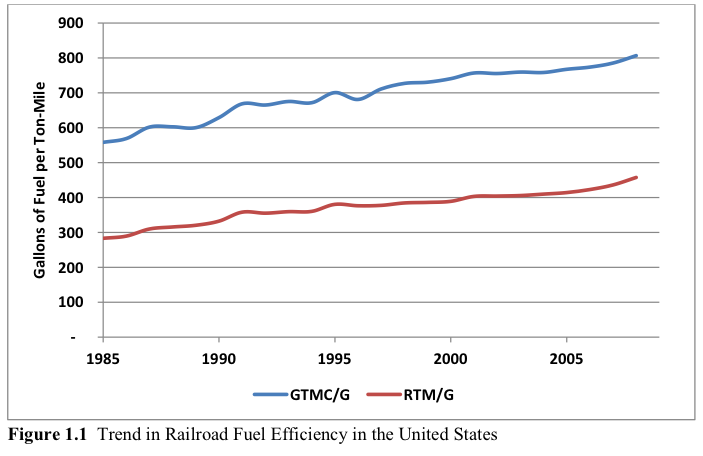UPPER GREAT PLAINS TRANSPORTATION INSTITUTE
Introduction
The fuel efficiency of freight transportation is a critical issue in the United States in light of the price volatility of fuels and America’s dependence upon foreign sources of petroleum. Moreover, fuel efficiency is important to environmental policy. The burning of fossil fuels for transportation purposes results in the emission of air pollutants such as nitrogen oxides, particulate matters, and volatile organic compounds. According to the U.S. Environmental Protection Agency (EPA), transportation is responsible for 27% of the total greenhouse gas emissions in the United States. Moreover, transportation is the fastest-growing source of greenhouse gas emissions, accounting for 47% of the net increase in U.S. emissions since 1990. Today, transportation is the largest end source of carbon dioxide (CO2), the most prevalent greenhouse gas. Because emissions increase with gallons of fuel consumed, fuel efficiency is a necessary condition for improved environmental quality.
Perhaps the most common measure of transportation fuel efficiency is revenue ton-miles per gallon (RTM/G), which is an indication of the transportation output produced by a gallon of fuel. It measures how many miles one ton of cargo can be moved with a gallon of fuel. On the basis of this measurement, U.S. railroads increased their fuel efficiency rating from 283 RTM/G in 1985 to 457 RTM/G in 2008 (Figure 1.1), which represents a 61% increase over 24 years, or a 2.6% annual growth rate. A complementary indicator of fuel efficiency is the gross ton-miles of cars and contents (GTMC) moved with a gallon of fuel. In addition to revenue or cargo tons, this indicator reflects the weights of containers, trailers, and freight cars. As shown in Figure 1.1, the gross ton-miles of cars and contents produced with each gallon of fuel (GTMC/G) has increased from 558 in 1985 to 806 in 2008, a 45% increase in 24 years, or a 1.9% annual growth rate.
As these trends suggest, there are two primary sources of energy efficiency gains. (1) Railroad fuel savings are due in large part to technological and operational efficiencies that have enabled the movement of a given quantity of weight with fewer gallons. (2) Higher levels of revenue ton-miles per gallon are attributable, at least in part, to moving more revenue tons in a single car—i.e., increasing the net to gross weight ratio. By either measure (GTMC/G or RTM/G), railroad fuel savings have increased dramatically in the United States since 1980, when the railroads were deregulated—a policy change that has allowed greater operational flexibility and spurred innovations leading to fuel savings.
With a few notable exceptions, most of the comparisons of modal fuel efficiencies have utilized system averages. While insightful, these generalizations do not distinguish among different types of operations, such as railroad unit trains versus individual carload shipments. The average railroad revenue ton-miles per gallon reflects all types of train movements (unit trains, mixed freight trains, and way or local trains), as well as commodities (bulk, neobulk, containers, etc.). As shown later, there are wide disparities in fuel efficiencies within these classes.
The main objectives of this study are to (1) conduct an analytical evaluation of movements using train resistance and fuel consumptions equations, (2) estimate a railroad fuel efficiency model that describes differences in fuel economy among classes of movements, (3) compare the results of the two methods to each other and to other studies, and (4) compare rail, truck, and waterway fuel efficiencies. Although container shipments are analyzed, the primary focus is on bulk commodity movements. The rest of the report is organized as follows. (1) The most relevant previous studies are reviewed. (2) Resistance equations are used to estimate the horsepower-hour requirements (and gallons of fuel consumed) for specific train movements. (3) Statistical equations are estimated from fuel and operational data reported by railroads to the U.S. Surface Transportation Board (STB) in the R-1 report. (4) The results of the analytical and statistical methods are compared. (5) The relative fuel efficiencies of the primary commodities transported by rail are analyzed using the waybill sample. (6) The energy efficiencies of railroads, trucks, and barges are compared for bulk commodity movements.
Read full report (PDF) here: Analysis of Railroad Energy Efficiency in the United States
About the Upper Great Plains Transportation Institute
www.ugpti.org
“The Upper Great Plains Transportation Institute (UGPTI) is an independent center at North Dakota State University which is guided, in part, by an advisory council composed of representatives of various organizations industries and agencies affecting or affected by transportation.”
Tags: Energy efficiency, Fossil Fuels, greenhouse gas emissions, Railroad, revenue ton-miles per gallon, Upper Great Plains Transportation Institute







 RSS Feed
RSS Feed